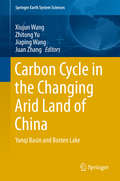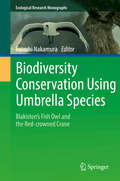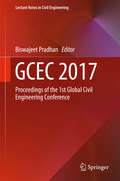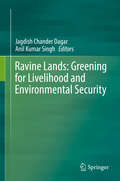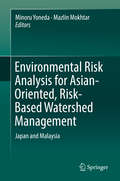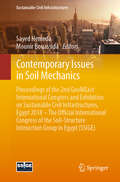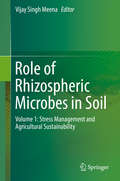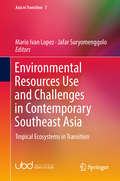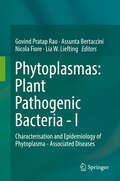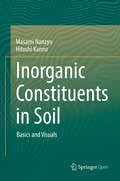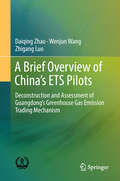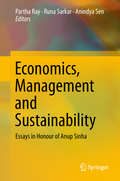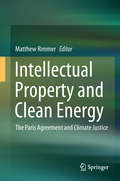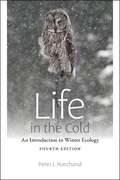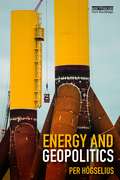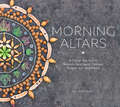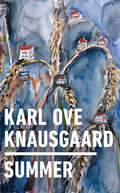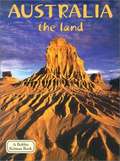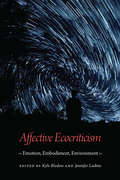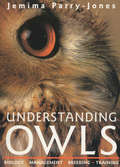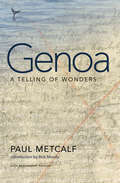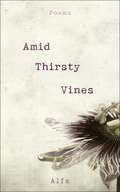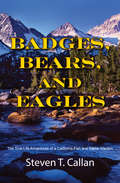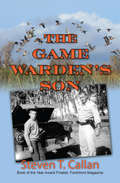- Table View
- List View
Carbon Cycle in the Changing Arid Land of China: Yanqi Basin And Bosten Lake (Springer Earth System Sciences Ser.)
by Juan Zhang Jiaping Wang Zhitong Yu Xiujun WangThis book integrates the analyses of organic carbon and carbonate accumulation in soil and lake sediment in a typical arid region of China that has experienced significant climate and land-use changes.It demonstrates that carbonate accumulation greatly exceeds organic carbon in both soil and sediment. It also shows that intensive cropping with sound land management in the arid land not only increases soil organic carbon stock, but also enhances accumulation of soil carbonate, particularly in subsoils. Carbon accumulation in the lake sediment increased between 1950 and 2000, after which it declined, and the authors explore how human activity and climate change may have caused the changes in carbon burial in the lake sediment.This book is of interest to researchers in a number of fields such as soil science, limnology and global change, as well as to the policy-makers.
Biodiversity Conservation Using Umbrella Species: Blakiston's Fish Owl And The Red-crowned Crane (Ecological Research Monographs)
by Futoshi NakamuraThis book focuses on Blakiston’s fish owl and the red-crowned crane as umbrella species. Healthy river, riparian and wetland ecosystems are necessary to maintain the populations of the two species. Both species have been revered by people since ancient times, but both are currently listed as endangered because of their small population sizes. The population decline of the two species can be mainly attributed to the degradation of the natural riparian and wetland habitats, which is associated with land use development.The populations of the two species are now recovering in Japan due to recent conservation and reproduction efforts, but the genetic diversity of the two species are still low due to previous bottleneck effects. To develop conservation and dispersal plans to establish the species over the East Asian mainland and on the island of Hokkaido, basic information, such as their regional distribution, genetic diversity, food availability, reproductive traits, and nesting, breeding, rearing, and commuting habitat, is essential. The intensive, collaborative studies conducted in Japan and Russia has clarified the status quo and the ecology of the two species. This is the first book that comprehensively compiles the above information for the mainland and island populations. In addition, it verifies their suitability as umbrella species of an ecosystem and the possibility of their future population expansion, taking into account changes in land use in Hokkaido, which is about to experience a dramatic decline in human population. As such, the book provides valuable information for students who wish to learn about these beautiful symbolic creatures, for NGOs engaged in conservation activities, and for managers who are involved in creating conservation plans and implementing restoration projects.
Gcec 2017: Proceedings Of The 1st Global Civil Engineering Conference (Lecture Notes in Civil Engineering #9)
by Biswajeet PradhanThis book gathers the proceedings of the 1st Global Civil Engineering Conference, GCEC 2017, held in Kuala Lumpur, Malaysia, on July 25–28, 2017. It highlights how state-of-the-art techniques and tools in various disciplines of Civil Engineering are being applied to solve real-world problems. The book presents interdisciplinary research, experimental and/or theoretical studies yielding new insights that will advance civil engineering methods. The scope of the book spans the following areas: Structural, Water Resources, Geotechnical, Construction, Transportation Engineering and Geospatial Engineering applications.
Ravine Lands: Greening for Livelihood and Environmental Security
by Anil Kumar Singh Jagdish Chander DagarThis book, the only one of its kind on ravine lands, reflects the significant advances made over the past two decades in our understanding of gully erosion, its controlling factors, and various aspects of gully erosion. It also addresses central research gaps and unanswered questions, which include historical studies on gully erosion to better understand the different stages of their formation; appropriate measuring techniques for monitoring or assessing the geological and hydrological parameters and processes involved in gully development; interaction of hydrological and other soil degradation processes; ecology and biodiversity of fragile ravines; impact of climate and environmental changes on soil erosion processes; development of effective and reliable gully erosion models; effective gully prevention and control measures; watershed-based management options; and ravine rehabilitation policies. The present book is a highly timely publication and deals with various aspects of ravine ecology and rehabilitation of degraded lands, particularly with the aid of biological approaches. As such, it offers a valuable guide for all scientists working in the fields of soil conservation / rehabilitation and agroforestry, students, environmentalists, educationists, and policymakers. More importantly, it focuses on the rehabilitation of one of the world’s most degraded and fragile ecosystems, ensuring the livelihoods of resource-poor farmers and landless families living in harsh ecologies that are more vulnerable to climate change.
Environmental Risk Analysis for Asian-Oriented, Risk-Based Watershed Management: Japan And Malaysia
by Mazlin Mokhtar Minoru YonedaThis publication is a practical guidebook on environmental risk assessment, especially for watershed-scale management. It highlights case studies of watershed environmental risk in Malaysia, including the potential health risks as well as screening methods and management in practice. In order to apply environmental risk assessment methods for the management of toxic chemicals, it is necessary to consider the geological and climate features of each country as well as their cultural characteristics. Focusing on Malaysia as a representative country, the book also discusses studies in other Asian countries. The insights provided can be applied to advanced and developing countries alike. A suitable textbook for graduate students, it is also a valuable reference source for researchers, practitioners and policymakers.
Contemporary Issues in Soil Mechanics: Proceedings of the 2nd GeoMEast International Congress and Exhibition on Sustainable Civil Infrastructures, Egypt 2018 – The Official International Congress of the Soil-Structure Interaction Group in Egypt (SSIGE) (Sustainable Civil Infrastructures)
by Sayed Hemeda Mounir BouassidaThis volume is of interest to practical engineers. It discusses some contemporary issues related to soil mechanics in earthwork projects which are critical components in civil construction and often require detailed management techniques and unique solution methods to address failures. Being earth bound, earthwork is influenced by geomaterial properties at the onset of a project. Hence, an understanding of the in-situ soil properties is essential. Slope stability is a common problem facing earthwork construction, such as excavations and shored structures. Analytical methods for slope stability remain critical for researchers due to the mechanical complexity of the system. Striving for better earthwork project managements, the geotechnical engineering community continues to find improved testing techniques for determining sensitive properties of soil and rock, including stress-wave based, non-destructive testing methods. To minimize failure during earthwork construction, past case studies and data may reveal useful lessons and information to improve project management and minimize economic losses. This volume discusses these aspects using appropriate methods in a simple way. The volume is based on the best contributions to the 2nd GeoMEast International Congress and Exhibition on Sustainable Civil Infrastructures, Egypt 2018 – The official international congress of the Soil-Structure Interaction Group in Egypt (SSIGE).
Role of Rhizospheric Microbes in Soil: Volume 2: Nutrient Management And Crop Improvement
by Vijay Singh MeenaIn any ecosystem, plant and microbe interaction is inevitable. They not only co-exist but also support each other’s survival and provide sustenance in stressful environments. Agro-ecosystems in many regions around the globe are affected by high temperatures, soil salinity/alkalinity, low pH and metal toxicity. High salinity and severe draught are other major constraints affecting agricultural practices and also plants in the wild. A major limiting factor affecting global agricultural productivity is environmental stresses. Apart from decreasing yield, they also have a devastating impact on plant growth. Plants battle with various kind of stresses with the help of symbiotic associations with the rhizospheric microbes. Naturally occuring plant-microbe interactions facilitate the survival of plants under these stressful conditions.The rhizosphere consists of several groups of microbes, plant growth-promoting bacteria (PGPB) is one such group of microbes that assists plants in coping with multiple stresses and also promote plant growth. These efficient microbes support the stress physiology of the plants and can be extremely useful in solving agricultural as well food- security problems.This book provides a detailed, holistic description of plant and microbe interaction. It elucidates various mechanisms of nutrient management, stress tolerance and enhanced crop productivity in the rhizosphere, discussing The rhizospheric flora and its importance in enhancement of plant growth, nutrient content, yield of various crops and vegetables as well as soil fertility and health. Divided into two volumes, the book addresses fundamentals, applications as well as research trends and new prospects for agricultural sustainability. Volume 1: Stress Management and Agricultural Sustainability, includes chapters offering a broad overview of plant stress management with the help of microbes. It also highlights the contribution of enzymatic and molecular events occurring in the rhizosphere due to plant microbe interactions, which in turn help in the biological control of plant disease and pest attacks. Various examples of plant microbe interaction in rhizospheric soil are elaborated to facilitate the development of efficient indigenous microbial consortia to enhance food and nutritional security. Providing a comprehensive information source on microbes and their role in agricultural and soil sustainability, this timely research book is of particular interest to students, academics and researchers working in the fields of microbiology, soil microbiology, biotechnology, agronomy, and the plant protection sciences, as well as for policy makers in the area of food security and sustainable agriculture.
Environmental Resources Use and Challenges in Contemporary Southeast Asia: Tropical Ecosystems In Transition (Asia in Transition #7)
by Jafar Suryomenggolo Mario Ivan LopezThis edited volume introduces dynamic approaches to the study of Southeast Asia’s environmental diversity from different disciplinary perspectives at the interface between the natural and social sciences. It brings together research on the region’s environmental resource use and shared ecological challenges in the context of present day globalization to offer insights for possible future directions. The book introduces unique approaches to the study of Southeast Asia’s environmental changes and resource management under the influence of intensifying economic change in the region. It also examines the slow erosion of Southeast Asia’s rich environment and addresses serious issues such as the decrease in biodiversity and tropical forests, and the degradation of peat lands. At the same time, it discusses the social issues that are tied to energy-dependent growth and have intensified over the last two decades. It also analyzes the new roadmaps being created to protect, conserve, and manage the environment. By investigating the many ecological issues surrounding us, the volume brings to light the constant struggles we face while trying to develop a more inclusive and equitable approach to natural resources governance. This volume is relevant for students, academics and researchers who have an interest in the Southeast Asian environment and the way in which we use and interact with it.
Phytoplasmas: Characterisation And Epidemiology Of Phytoplasma - Associated Diseases
by Lia W. Liefting Nicola Fiore Assunta Bertaccini Govind Pratap RaoPhytoplasma-associated diseases are a major limiting factor to quality and productivity of many ornamentals, horticultural and other economically important agriculture crops worldwide. Annual losses due to phytoplasma diseases in many crops vary, but under the pathogen favorable conditions they always lead to disastrous consequences to farming community. As there is no effective cure for phytoplasma diseases, the management options emphasize on their exclusion, minimizing their spread by insect vectors and propagation materials and on development of host plant resistance. The phytoplasma associated plant diseases have a history of more than 50 years. Phytoplasmas have undoubtedly infected plants and cause diseases for centuries before they are described and proven to be the causal agents. But important progress related to identification of phytoplasmas only began after 1980’s. Phytoplasmas have emerged as the most serious constraints in the production of several crops all around the world during last four decades. Phytoplasmas constitute a major limiting factor to quality and productivity of cereals, horticultural, ornamentals and many other economically important crops all over the world. Annual losses due to phytoplasma diseases may vary, but under the pathogen favorable condition, phytoplasma disease may lead to disastrous consequences for farming and industry community. The scientific literature concerning phytoplasma occurrence, characterization, diagnosis, detection, and management is growing at a fast pace. Significant advancement in the last decades on diagnostic, biological and molecular properties, epidemiology, host-pathogen-insect interactions as well as management of phytoplasmas has been made. Till date, no authentic compilation is available to know the progress of phytoplasmas characterization major crops all over the world. The planned book will compile all the updated information available information on phytoplasmas by distinguished experts in the form of edited book entitled “Characterization and epidemiology of phytoplasma associated diseases”. The book covers recent and update information on emerging and re-emerging phytoplasma diseases affecting important crops in tropics and subtropics. It provides comprehensive information on disease distribution, occurrence, and identification of the phytoplasmas including the recent approaches for diagnostics, transmission, and information about losses and geographical distribution along with and management aspects. This volume contains 11-12 chapters contributed by the experienced and recognized experts working on different group of phytoplasmas affecting major crops all over the world. The information on various topics is at advanced as well as comprehensive level and provides the period wise developments of phytoplasma research. The book covers major chapters on an up to date progress of phytoplasma research, and then phytoplasma diseases associated with vegetable, pulse, oils crops, cereals, sugar crops, fruit crops, ornamentals, medicinal plants, palms species, forest tress and weeds. We have covered historical background, geographical distribution, identification and characterization, genetic diversity, host pathogen interaction and management aspects of important phytoplasma diseases infecting our major agricultural crops. The information on various topics is advanced as well as comprehensive, and provides thought provoking ideas for planning novel research ideas for future. This book will be useful to everyone interested in mollicutes, phytoplasma, spiroplasmas, plant pathology, disease control and plant biology and serve as an exhaustive and up-to-date compendium of references on various aspects of different groups of phytoplasmas affecting important crops worldwide.
Inorganic Constituents in Soil: Basics and Visuals
by Masami Nanzyo Hitoshi KannoThis open access book is a must-read for students of and beginners in soil science. In a well-organized and easy-to-follow manner, it provides basic outlines of soil minerals, new methods and recent developments in the field, with a special focus on visual aids. The chapters on primary minerals, secondary minerals, non-crystalline inorganic constituents and inorganic constituents sensitive to varying redox conditions will help readers understand the basic components of soils. Further, readers are introduced to new analytical methods with the aid of microscopy and recent developments in the field. Uniquely, the book features case studies on the identification and isolation methods for vivianite crystals from paddy field soils, as well as a useful procedure for identifying noncrystalline constituents such as volcanic glasses and plant opals, which can also be applied to other soils depending on the local conditions.Given its focus and coverage, the book will be useful to all readers who are interested in agronomy, plant production science, agricultural chemistry and environmental science. In addition, it can help biogeochemists further expand their research work on the rhizosphere of wetland plant roots, iron and phosphate dynamics, etc.
A Brief Overview of China’s ETS Pilots: Deconstruction And Assessment Of Guangdong's Greenhouse Gas Emission Trading Mechanism
by Zhigang Luo Wenjun Wang Daiqing ZhaoThis book systematically introduces readers to the framework of China’s ETS pilots, exploring their design and operating process, the current state of the carbon market, and various barriers encountered. To do so, it deconstructs the Guangdong ETS, which is the largest and most representative of China’s seven ETS pilots. The book subsequently describes and evaluates all seven pilots in terms of their efficiency, macro and micro effects, the method involved in the DEA model, the CGE model, and cost-benefit analysis. In turn, in the assessment section it demonstrates how some ETS pilots have failed to control carbon emissions due to inordinately high emissions quotas issued by the local government etc. Further, it argues that ETS should focus on those industries with large emissions and high mitigating potential for the time being, and then gradually expand the scale of its coverage.As China’s national ETS is slated for launch on the basis of the lessons learned from the ETS pilots, the book offers a timely and valuable resource for all those who want to understand and forecast the development of China’s ETS. It includes a wealth of descriptions and explanations of Chinese government policies involving carbon emissions control, making it a unique resource.
Economics, Management and Sustainability: Essays In Honour Of Anup Sinha (India Studies in Business and Economics)
by Anindya Sen Runa Sarkar Partha RayThis book presents an eclectic mix of interesting new areas in the domain of economics, management and sustainability. Written by leading experts, it provides valuable food for thought, with essays introducing new lines of research and empirical research papers offering sound research methodology. The book not only provides answers, but also raises numerous interesting questions concerning the areas covered to whet readers’ appetites to learn more. Professor Anup Sinha is a respected teacher and is a great mind with wide-ranging academic interests spanning from economics and sustainability to management. As well as in various other places in India and the US, he has taught at the Indian Institute of Management Calcutta and Presidency College (now a University) Calcutta for almost three decades. To commemorate his contributions, this festschrift presents a collection of essays that are broadly subdivided into four sections: Economic Development; Vulnerabilities and Inclusive Growth; Sustainability and Corporate Governance; and Innovation and Management.
Intellectual Property and Clean Energy: The Paris Agreement and Climate Justice
by Matthew RimmerThis collection considers the future of climate innovation after the Paris Agreement. It analyses the debate over intellectual property and climate change in a range of forums – including the climate talks, the World Trade Organization, and the World Intellectual Property Organization, as well as multilateral institutions dealing with food, health, and biodiversity. The book investigates the critical role patent law plays in providing incentives for renewable energy and access to critical inventions for the greater public good, as well as plant breeders’ rights and their impact upon food security and climate change. Also considered is how access to genetic resources raises questions about biodiversity and climate change. This collection also explores the significant impact of trademark law in terms of green trademarks, eco labels, and greenwashing. The key role played by copyright law in respect of access to environmental information is also considered. The book also looks at deadlocks in the debate over intellectual property and climate change, and provides theoretical, policy, and practical solutions to overcome such impasses.
Life in the Cold: An Introduction to Winter Ecology, Fourth Edition
by Peter J. MarchandPeter J. Marchand’s Life in the Cold remains the one book that offers a comprehensive picture of the interactions of plants and animals—including humans—with their cold-weather environment. Focusing on the problems of “winter-active” organisms, Marchand illuminates the many challenges of sustaining life in places that demand extraordinary adaptations. The fourth edition of this classic text includes a new chapter on climate change and its effects on plants and animals wintering in the North.
Energy and Geopolitics
by Per HögseliusThe idea that energy shapes and is shaped by geopolitics is firmly rooted in the popular imagination – and not without reason. Very few countries have the means to secure their energy needs through locally available supplies; instead, enduring dependencies upon other countries have developed. Given energy’s strategic significance, supply systems for fuels and electricity are now seamlessly interwoven with foreign policy and global politics. Energy and Geopolitics enables students to enhance their understanding and sharpen their analytical skills with respect to the complex relations between energy supply, energy markets and international politics. Per Högselius guides us through the complexities of world energy and international energy relations, examining a wide spectrum of fossil fuels, alongside nuclear and renewable energies. Uniquely, the book also shows how the geopolitics of energy is not merely a matter for the great powers and reveals how actors in the world’s smaller nations are as active in their quest for power and control. Encouraging students to apply a number of central concepts and theoretical ideas to different energy sources within a multitude of geographical, political and historical contexts, this book will be a vital resource to students and scholars of geopolitics, energy security and international environmental policy and politics.
Morning Altars: A 7-step Practice To Nourish Your Spirit Through Nature, Art, And Ritual
by Day SchildkretReturn to the earth with beautiful photographs and inspirational text. “Morning altars” are colorful mandalas that combine nature, art, and meditation. Incorporating the natural world into the everyday encourages positive well- being, even with the simplest of the earth’s gifts, such as leaves, flowers, berries, feathers, and stones. These stunning pieces of art are a peaceful and creative avenue to express gratitude for nature, to practice mindfulness, and to add meaning to daily life. In this book, Day Schildkret guides readers through the creation of morning altars, a seven- step process that includes wondering and wandering, place meditation, clearing space, creating, gifting, walking away, and sharing his art with others. Since his first morning altar, Schildkret has built hundreds more. His work has been warmly received on social media and he teaches workshops on altar building, all with the intention of sharing the positivity and beauty they have brought to his life.
Summer (Seasons Quartet Ser. #4)
by Anselm Kiefer Karl Ove KnausgaardThe grand finale of Karl Ove Knausgaard's masterful and intensely-personal series about the four seasons, illustrated with paintings by the great German artist Anselm Kiefer.2 June--It is completely dark out now. It is twenty-three minutes to midnight and you have already slept for four hours. What you will dream of tonight, no one will ever know. Even if you were to remember it when you wake up, you wouldn't have a language in which to communicate it to us, nor do I think that you quite understand what dreams are, I think that is still undefined for you, that your thoughts haven't grasped it yet, and that it therefore lies within that strange zone where it neither exists nor doesn't exist. <P><P>The conclusion to one of the most extraordinary and original literary projects in recent years, Summer once again intersperses short vividly descriptive essays with emotionally-raw diary entries addressed directly to Knausgaard's newborn daughter. Writing more expansively and, if it is possible, even more intimately and unguardedly than in the previous three volumes, he mines with new depth his difficult memories of his childhood and fraught relationship with his own father. Documenting his family's life in rural Sweden and reflecting on a characteristically eclectic array of subjects--mosquitoes, barbeques, cynicism, and skin, to name just a few--he braids the various threads of the previous volumes into a moving conclusion. At his most voluminous since My Struggle, his epic sensational series, Knausgaard writes for his daughter, striving to make ready and give meaning to a world at once indifferent and achingly beautiful. In his hands, the overwhelming joys and insoluble pains of family and parenthood come alive with uncommon feeling.
Australia: The Land (Lands, Peoples, and Cultures)
by Erinn BantingEarth did not always look as it does today. Hundreds of millions of years ago, it was covered by one enormous landmass called Pangaea. About 200 million years ago, Pangaea began to split in two. Slowly, the two pieces drifted farther apart and split into even more pieces. Eventually, the seven continents formed: North America, South America, Europe, Asia, Africa, Australia, and Antarctica. Australia and Antarctica drifted the farthest south, into the southern hemisphere.
Affective Ecocriticism: Emotion, Embodiment, Environment
by Kyle Bladow Jennifer LadinoScholars of ecocriticism have long tried to articulate emotional relationships to environments. Only recently, however, have they begun to draw on the complex interdisciplinary body of research known as affect theory. Affective Ecocriticism takes as its premise that ecocritical scholarship has much to gain from the rich work on affect and emotion happening within social and cultural theory, geography, psychology, philosophy, queer theory, feminist theory, narratology, and neuroscience, among others. This vibrant and important volume imagines a more affective—and consequently more effective—ecocriticism, as well as a more environmentally attuned affect studies. These interdisciplinary essays model a range of approaches to emotion and affect in considering a variety of primary texts, including short story collections, films, poetry, curricular programs, and contentious geopolitical locales such as Canada’s Tar Sands. Several chapters deal skeptically with familiar environmentalist affects like love, hope, resilience, and optimism; others consider what are often understood as negative emotions, such as anxiety, disappointment, and homesickness—all with an eye toward reinvigorating or reconsidering their utility for the environmental humanities and environmentalism. Affective Ecocriticism offers an accessible approach to this theoretical intersection that will speak to readers across multiple disciplinary and geographic locations.
Crusoe, the Worldly Wiener Dog: Further Adventures with the Celebrity Dachshund
by Ryan BeauchesneThe New York Times bestselling, popular blogger, internet sensation Crusoe, the Celebrity Dachshund returns with a beautiful and whimsical book full of heartwarming and goofy photographs of his around the world travels in Crusoe, the Worldly Wiener Dog.Join the photogenic Crusoe as he leaves fame and fortune behind to expand his horizons, get his passport stamped, and journey across the globe to eat delicious food, relax on beautiful beaches, dig lots of holes, and generally enjoy all that celebrity travel has to offer. You'll also get to see a little of his "staycations" and life at home between travels.Jet-setting is what dachshunds do best. From Switzerland’s Alps and Mexico’s Mayan temples to Italy’s seaside villages and France’s Eiffel Tower—as well as various locales throughout the U.S. and Canada—Crusoe shares his wit and wisdom on appreciating culture, fine wine, and haute cuisine, always dressing for the occasion, and maybe learning a thing or two about what really matters most in life along the way.In hundreds of brilliant color photographs, see the charming and charismatic mini-doxie embark on such thrilling adventures as…* Hitting the streets of New York City as The Wiener of Wall Street* Stalking evildoers as Batdog * Strolling Hollywood’s Walk of Fame (with his own star)* Going out on a dinner and movie date with the lovely Paisley* Digging for fossils at Dinosaur Provincial Park* Playing doctor and dentist to his sidekick brother, Oakley* Drinking at the notorious Bar Vitelli, shooting location of The Godfather* Recovering from back surgery with lots of love and rehabilitating in style * Tasting a beignet at New Orleans’s famous Café du Monde* Exploring his German heritage as a “badger dog”—and discovering what wiener schnitzel actually is…And so much more!
Understanding Owls: Biology, Management, Breeding, Training
by Jemima Parry-JonesThe only guide to every aspect of living and working with owls, wirtten by one of the world's top experts in the field of birds of prey: Jemima Parry-Jones, owner of the world-famous National Birds of Prey Centre. Owls have become increasingly popular as pets, as birds that specialists want to breed, or that people want to fly for pleasure, or to train and fly for demonstrations at zoos and bird of prey centres, and even as birds to use for hunting. It will help you understand owls to assure your own owl of the best possible situation in captivity. Jemima Parry-Jones covers everything to help you learn more about owls, either to keep them, breed them, or to train and fly one: taxonomy, biology; owl anatomy, morphology and behavior, housing and equipment, breeding owls, incubation, rearing, maintaining and managing your owls, training and hunting.
Genoa: A Telling of Wonders
by Rick Moody Paul Metcalf"[Genoa] invites us to pass our minds down a new but ancient track, to become, ourselves, both fact and fiction, and to discover something true about the geography of time."--William Gass, The New York Times"Genoa is a spectacular confrontation with Melville's work, the journals of Columbus and molecular biology--all folded into a hallucinatory narrative about two brothers and their different paths through the American century."--Publishers Weekly"Much like his great-grandfather, Herman Melville, Paul Metcalf brings an extraordinary diversity of materials into the complex patterns of analogy and metaphor, to affect a common term altogether brilliant in its imagination."--Robert Creeley"A unique work of historical and literary imagination, eloquent and powerful. I know of nothing like it."--Howard ZinnFirst published in 1965, Genoa is Paul Metcalf's purging of the burden of his relationship to his great-grandfather Herman Melville. In his signature polyphonic style, a storm-tossed Indiana attic becomes the site of a reckoning with the life of Melville; with Columbus, and his myth; and between two brothers--one, an MD who refuses to practice; the other, an executed murderer. Genoa is a triumph, a novel without peer, that vibrates and sings a quintessentially American song.Paul Metcalf (1917-99) was an American writer and the great-grandson of Herman Melville. His three volume Collected Works were published by Coffee House Press in 1996.
Amid Thirsty Vines: Poems
by AlfaThemes of self-discovery, tending the garden of the soul, and nurturing yourself into blossom, Amid Thirsty Vines by Instagram poetry star Alfa is the collection you need to feel the power of the beautiful flowers within you, and to find the love you deserve. This volume belongs in the collection of every modern poetry fan.
Badges, Bears, and Eagles: The True-Life Adventures of a California Fish and Game Warden
by Steven T. Callan“This engrossing memoir by debut author Callan lets readers in on highlights of his 30-year career as a California wildlife officer” (Publishers Weekly, starred review). Over his thirty-year career as a wildlife protection officer for the California Department of Fish and Game, Steve Callan and his longtime working partner, Dave Szody, conducted some of the most fascinating, complex, and highly successful wildlife investigations in California history. They also collected a wealth of true stories—action-packed, suspenseful, and often humorous. In Badges, Bears, and Eagles, Steve provides a vivid first-person account of his “jaw-dropping, funny, tragic, enraging, exciting, and hopeful” adventures (Publishers Weekly, starred review). The author and his colleagues outsmart game hogs, thwart fish thieves, and foil outlaws with names like “Squeaky.” Steve is even stalked by African lions and mauled by a five-hundred-pound Bengal tiger. One of the most important cases of his career begins with a slain bald eagle dropped on the doorstep of the Fish and Game office, along with a note threatening the life of a fellow warden. A decade later, Steve and Dave conduct the investigation of their lives, uncovering a statewide criminal conspiracy to kill California black bears for their valuable gall bladders. These and other fascinating stories make for a truly unique, “exceptionally well written” memoir of conservation that “is almost flawless, and reading this gem is pure effortless joy” (International Game Warden).
The Game Warden's Son
by Steven T. CallanA game warden’s “dynamic and authoritative” memoir of protecting the wild, named Best Outdoor Book of 2016 by the Outdoor Writers Association of California (New York Daily News). Retired game warden Steven T. Callan’s love of nature and passion for protecting wildlife took root long before the adventures he describes in his acclaimed memoir, Badges, Bears, and Eagles. In this follow up, he intertwines more than a half-century of adventures and investigations with stories of his relationship with his father. After an idyllic boyhood spent riding on patrol with his father in the canyons and beaches of California, Steven himself became a game warden in the early 1970s, joining the “desert rats” who patrolled the counties along the Colorado River. With wry humor, Callan tells how he and fellow officers outwitted perpetrators—most of them crafty, some of them hilariously foolish—who poached deer, lobsters, and abalone, baited bears, shot wild ducks to supply restaurants, and killed songbirds for epicurean dinner tables. Their cases took them across the Channel Islands, through the back alleys of San Francisco, into the Sierras, and along California’s pristine North Coast—all to protect California’s natural resources for future generations. “Callan’s writing is dynamic and authoritative, with an episodic structure that will keep experts and novice readers turning the pages” (New York Daily News).
